Do you want to use non chord tones in your music?
The non-chord tones can spice up your music by providing movement, tension, and dissonance to it. The tension needs to be resolved by returning back to chord tones in subsequent chords.
We will discuss various categories of non-chord tones, like accented and unaccented, and their different types in our article. These include the passing tones, neighboring tones, suspensions, retardations, Appoggiaturas, escape tones, anticipation, pedal, and the double neighbor chord tones.
Please read the complete article to get an in-depth view of the chord tones and their use in modern-day music!
What are Non-Harmonic Tones or Embellishing tones?
The non-chord tones (NCT) are also called the non-harmonic tones and the embellishing tones. They are defined in Western music as the note or tone in a piece of music that does not form part of the chord being played out at the time. So the differentiation between a chord tone or a nonchord tone boils down to their being part of the chord notes or not at the time the concerned chord was played.
Most nonchord tones have an interval of second, seventh, or fourth with the root. These intervals, particularly the first two, are dissonant intervals that have a tendency to resolve to a chord tone. They may create a 7th or an extended chord if they do not resolve to a chord tone.
There are nine main types of nonharmonic tones based on how you approach them and how you exit from them. This means they follow a pattern of Approach – Dissonance – Resolution. All the types are discussed below with relevant examples so that you clearly understand them.
The nonchord tones are also differentiated into various categories, known as the qualifiers, such as accented, unaccented, chromatic, metrical, sub, and super-metrical.
Categories of the Non Chord Tones
The non-chord tones are categorized into the following basic categories, as explained briefly.
- Accented – Accented non-chord tones grab maximum attention and occur on the beat. The Suspensions and Appoggiaturas are always accented. The duration of the tone is also important, in addition to its being on a strong beat. As you may be aware, the first beat in a 4/4 signature has the strongest accent and is also known as the “downbeat.” The 1st and the 3rd beats are the strong beats or the “on-beats.”
- Unaccented – It occurs on the weak part of the beat. In a 4/4 time signature, the second and the fourth beats are the weak beats, also known as the “off-beats.”
- Metrical – Exactly equal to the duration of the beat.
- Sub-metrical – Less than the duration of the beat.
- Super-metrical – More than the duration of the beat.
- Chromatic – The notes of the chromatic non-chord tones do not belong to the key.
Types of Non-Chord Tones
Let us now discuss the details of the individual types of nonchord tones with examples to illustrate their usage.
Passing Tone (PT)
A passing tone is a non-chord tone (NCT) that is accessed from the chord tone in the approach chord in a step movement. It resolves to another chord tone in the continued step movement in the same direction. Hence the passing tones are classified as the ascending or descending type depending on their step movement in the upward or downward direction.
This means if a non-harmonic tone is approached in an upward step movement from a note in Chord A, it continues in the upward step movement and resolves to a note in Chord B.
Consider the below example of a passing note in G major, where a passing tone for the chord is introduced in the Soprano voice between I and V6 chords from B to C in an upward step movement. It resolves to D in the V6 chord through an upward step movement again.
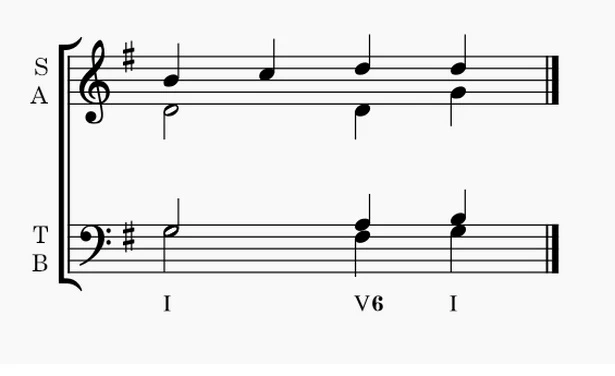
The passing tone occurs on a weak beat and is usually unaccented. The accented passing tone is possible but is used less. You can get it if the passing tone occurs on the second of two chords (instead of being in the middle of two chords) and then resolves after the second chord is played in full and held.
The passing tone can occur on two voices simultaneously. So we can have two passing tones in one chord in some situations.
Neighbor Tone (NT)
The neighboring tone is an embellishment tone that is approached by a step motion and resolves by a step movement in the opposite direction.
Consider the case of the same triads as in the previous example. It is shown in the diagram below.
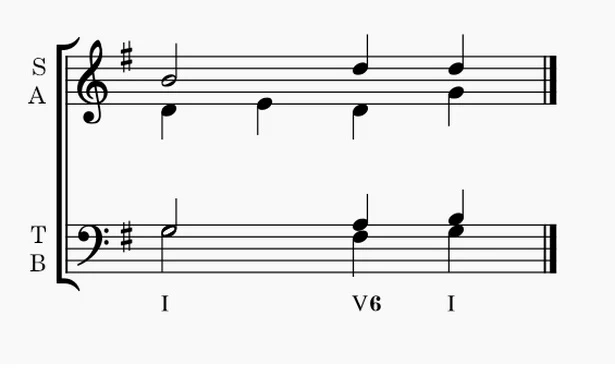
For the neighboring NCT, you should select two chord tones that are common in the two chords. In the present case, it is the Alto voice, D note which is common in I and V6 chords. So you can introduce a neighboring NCT, E, between the two chords.
The neighboring tones can be classified as an upper or a lower neighbor tone depending on the direction of the initial step movement. Some texts also use the term neighbor note, which specifically refers to a lower neighbor note with an interval of a half step. They are more frequently of unaccented type and occur on a weak beat.
They can further be subdivided into a complete neighbor tone and incomplete neighbor tones. An incomplete neighbor tone is when the approach motion is by a leap. So, the two tones on either side of the non-chord tone are not the same. Appoggiatura, which we will discuss later, is an accented incomplete neighbor tone.
The suspension (S)
The suspension is always approached by a common tone and resolves a step-down. It is always an accented type of NCT that occurs on a strong beat. The steps of suspension are preparation, suspension, and resolution.
The suspension means a chord note is suspended, temporarily held, or carried over to the next chord by playing again. The suspension may be through a tied note. The suspended note does not belong to the new chord. It eventually resolves to the chord tone by a step downwards. The diagram below shows a typical example of a suspension.

See that The G note in V6 is tied with the G note in the tonic chord and resolves to F# in the D/F# (V6 chord).
The suspension can happen in any of the voices.
The suspension is described by two numbers, like the suspension in the example is a 2 – 3 suspension. This number is derived in one of the following two ways.
- Find out the interval between the suspension and the bass note. Label it X. Then calculate the interval between the bass note and the resolved note. Label it Y. Then, X – Y is the suspension number.
- If the suspension is in the bass voice. Find out the most dissonant interval with the bass and use it to derive the two numbers, X and Y, in step 1 above.
If you encounter intervals like 11th or 10th, you must bring them down to simple suspensions, like 4 – 3. The only exception is a 9 – 8 suspension. The suspensions 6 – 5, 4 – 3, and 9 – 8 are common for triads in the root position. In inversions, 7-6 is very commonly observed.
In our example, the bass voice carried the suspension. The bass note G has three intervals A (2nd), D (5th), and D (CP5). So the most dissonant interval is with A, a 2nd. Further, A has an interval of 3rd with F#. So the suspension number is 2 – 3.
Another example of suspension is shown below.
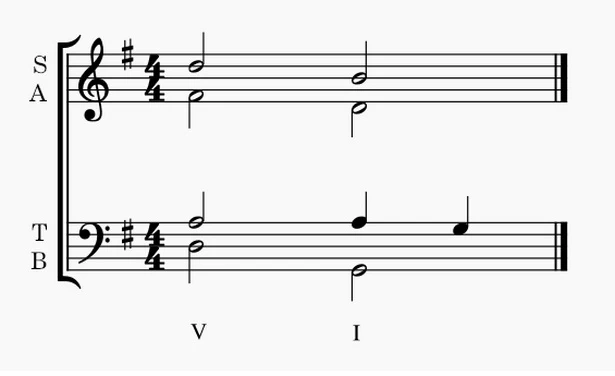
Note that A in the V chord is suspended in the I chord and eventually resolves to G. The interval between suspension G and the bass voice A is a 9th, which falls back to an 8th when A resolves. Hence the suspension here is 9-8.
Retardation (R)
Retardation is the opposite of suspension. It is also prepared by a common tone and resolves by a step up to a chord tone in the 2nd chord. It is an accented type of NCT that occurs on a strong beat.

See the above example of the retardation, where the note F# for the I chord (F major) is held and resolved upward by a step to a G.
The preparation is consonant, and the nonchord tone is dissonant, which resolves to a consonant chord tone.
Appoggiatura (APP)
It is an accented type of non-chord tone that occurs on a strong beat. It is approached by a leap from the approach chord and resolves in the opposite direction by a step. The approach can be a leap up or a leap down. Similarly, the step can also be in an up or down direction but must be opposite to the leap. You can see the example of Appoggiatura in the diagram below.
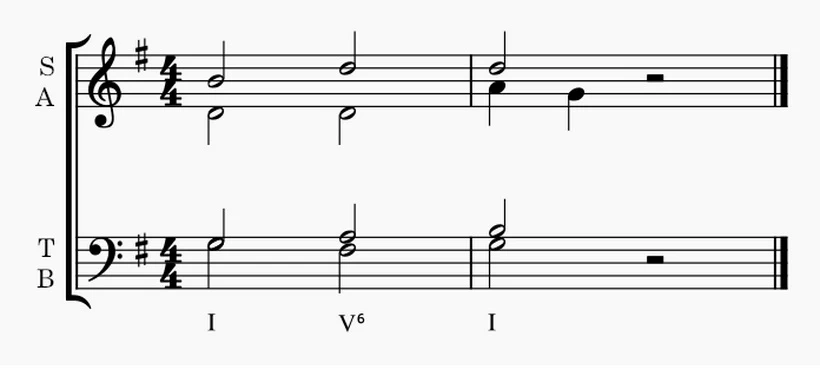
The D tone in the V6 chord in the Alto voice leaps to an A before resolving to G.
Escape Tone (ET)
Just like suspension and retardation are opposite to each other in approach and resolution, the Appoggiatura and the escape tones are also opposite to each other. Hence, in an escape tone, the approach is a step from any direction. The resolution is by a leap in the opposite one. The escape tone falls in the unaccented category and usually occurs on a weak beat. The diagram below shows an example of the escape tone.
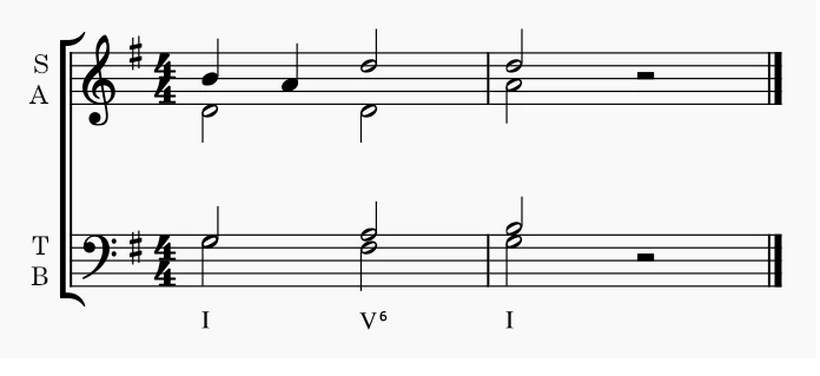
As you can see, the B note steps down to A in the Soprano and resolves up by a leap to D in the first inversion of the D major chord. A is an embellishing tone which is a non-chromatic note for G major.
You hear the complete G chord on the first beat. The change from B to A in the upper voice happens during the second beat.
Anticipation (Ant)
Next in the series is anticipation, which can be approached either through a step or a leap but must resolve on the same note, which means a common tone. It is on a weak beat and belongs to the unaccented category. It is shown in the diagram below.
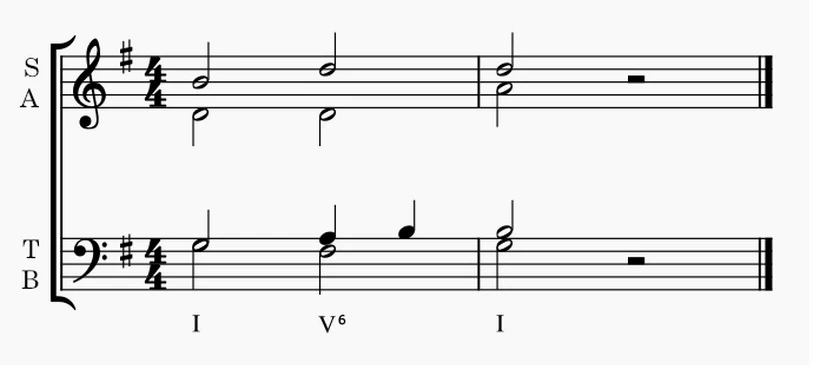
You can visualize anticipation as an early transition of a voice in the chord to a nonharmonic tone in anticipation of the new chord tone for that voice. Note that the tone A in the Tenor voice moves to B while the harmonic progression is still at the V6 chord. It is like a tone of the new chord played early. Note that B is the tone in the Tenor voice of the target chord I.
Did you note the difference between anticipation and suspension/retardation? The suspension and retardation get into the final chord tone delayed, and the anticipation moves into it early.
Pedal Point (PED)
The Pedal tone is approached by a common tone and resolves to a common tone. It is usually a note held during the chord changes in the progression and mainly occurs in the bass voice. It can appear in some cases in upper voices, where it is referred to as the upper pedal. If two notes act as pedal points, you have a case of a double pedal point. If these two points are between upper and lower voices, it is known as the internal pedal.
The pedal note usually belongs to the scale degree 1 and 5. It is a chord tone in the first chord, becomes a non-chord tone in the following chord, and returns back as the chord tone in the third chord. The diagram below shows you the pedal point in a chord sequence below.
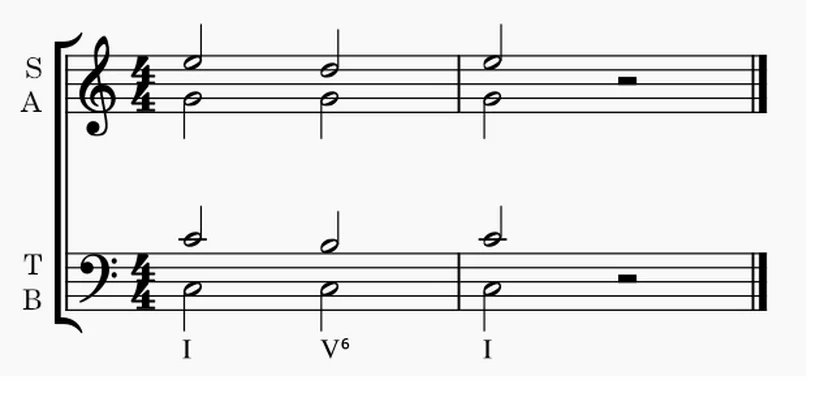
The chords are in the key of C major. The first inversion of the G major chord (V chord) has the notes [B D G], but we have to hold the C note from the previous chord as the bass note till the final C major chord. They are neither accented nor unaccented.
Double Neighbor Tones OR Neighbor Group (DN Or NG)
The last type involves more than one non-chord tone, usually two. Hence it is often called double neighboring tones or a neighbor group. In the section on the neighboring tones, you saw that they are of two types – the upper and the lower neighboring tones.
The neighbor group carries both types. Hence you go through the upper and the lower neighboring tones before you return back to the chord tones. It is very easy to confuse them with the escape tones and the appoggiaturas. Be careful and keep track of the chord tones correctly to avoid these errors.
The neighboring group is approached by a step and resolves by a step. Their use is shown in the diagram below.

Note that the D note in the Alto of the I chord steps into the E note and then moves to the C note. It finally moves n a step motion to resolve upward back to the D note.
The total movements in the present case can be summarized as a step upward movement, followed by a leap downwards by a 3rd interval, and finally, a step upwards in the same direction as the first movement. The two neighbors are used between the same chord tone in the two chords on either side. They can be of accented or unaccented type.
You can first have a lower neighbor than an upper neighbor as well.
Chromatic Non-Harmonic Tones
A non-chord tone is labeled as chromatic if it does not belong to the key. Their use usually involves a movement by a half step and is used mostly as the chromatic passing tones and chromatic appoggiaturas.
Conclusion
We hope our explanations for the non-chord passing tones have been clear and concise. If you still have doubts, you can write to us in the comments section below, and we will try to respond back to your queries ASAP.

